What does brown bloom on gooseberry berries mean, and how to save the crop
Gooseberry is a popular summer cottage culture, and one of the most hardy and productive. But many gardeners were faced with the fact that the berries and leaves were covered with a brown coating or film. What could it be? In the vast majority of cases - powdery mildew. The disease is contagious and calmly waiting out winter or drought in the soil until the conditions are right to fill the bushes.
What is this disease?
Powdery mildew is a very common and dangerous disease of a fungal nature. A small contact of diseased shoots or leaves with other plants is enough, and at the time of spore maturation, a strong gust of wind is enough for the infection to spread to neighboring bushes. Therefore, it is so important to fight mold from the first signs of the disease.
The following signs indicate powdery mildew:
- on thin shoots, leaves and fruits, a loose white coating appears, similar to a thin layer of flour;
- later the plaque darkens to brown, sometimes black;
- the fruits do not grow and do not ripen, but simply change shape, drying out over time;
- leaves affected by plaque curl, wither, and then fall off.
First, spots appear on the fruits, and then they are thrown onto the leaves, shoots. Over time, their number increases, and then individual spots merge altogether.
It is advisable not to let the mold spots darken, and to start the fight against the fungus in a timely manner.
Reasons for infection
Powdery mildew spores live on the ground or fallen leaves for several years - drought, heat, cold and other extreme tests do not cause them the slightest harm.
Awakening occurs only with a sharp increase in humidity.
Ideal conditions for the development of powdery mildew:
- rainy summer, when the sun rarely peeps through the clouds and does not warm the ground and bushes well;
- too active artificial humidification;
- strong thickening of plantings and the prevalence of weeds, which lead to stagnation of damp air in the center of the curtain;
- clay soils, due to which moisture is too slow to leave, stagnant in puddles, and the lack of a drainage system.
We treat folk remedies
Every experienced summer resident knows many ways to clean the bushes from white and even brown bloom. Yes, folk remedies are in most cases less effective than special drugs. But they undoubtedly have a merit - ecological cleanliness. They can be used almost at any time - even during flowering and when the fruit is ripening.
Advice
Traditional medicinal solutions are quickly washed off with water. To keep them on the leaves, the stickiness of the solutions is increased by adding about 40 g of soap shavings per 10 liters of water.
Some of the most reliable and proven recipes
Potassium permanganate, or potassium permanganate. Simple, affordable and reliable powdery mildew treatment. Another significant advantage is the speed of preparation of the solution:
- Pour 1.5 g of powder into a bucket of water.
- Stir thoroughly so that no sediment remains.
- Undissolved crystals are dangerous because they will burn the plants. To be on the safe side, you need to filter the solution through several layers of gauze.
- Spray the affected bushes with pink liquid.
- Repeat the treatment after a week or earlier if it rains heavily.
Wood ash. This is a more effective folk remedy, but it requires some preparation, so it makes sense to use it if powdery mildew has just appeared on the bushes or if there is simply such a threat - for example, if gooseberry bushes in the neighborhood were affected.
Advice
Experts recommend taking birch ash, absolutely clean, without any impurities - after all, in stoves and on fires, in addition to firewood, they often burn various garbage.
How to cook:
- 10 liters of water are taken per kilogram of ash.
- The components are mixed, after which the solution is infused for about a week.
- Before starting the treatment of the bushes, the product is well mixed.
Spraying should be done every two days. Most often, three to four sessions are enough to completely solve the problem of powdery mildew.
We use special preparations
Chemicals are more effective and can cope with infection in just one or two sessions. However, there is a drawback: they are environmentally hazardous. Therefore, they must be applied very carefully and in a timely manner.
Mandatory security measures:
- You cannot process the bushes during flowering, otherwise the bees pollinating the gooseberries will die or they will not approach the flowers.
- Chemical preparations are not used during the formation and after the formation of the fruit - the poison will settle on the skin of the fruit and accumulate in the pulp.
The best drugs
Copper sulfate. It is a proven remedy for many decades. The procedure for preparing the solution is very simple: 100 g of the substance per 10 liters of water. And you can immediately start processing.
"Topaz". A special fungicide that has become increasingly popular in recent years. It is sold in many country shops in ampoules. One of them is diluted in a 10-liter bucket of water, and the product is immediately ready for use.
An important advantage of the product is resistance to washing off. Even after a heavy downpour, a thin Topaz film remains on the leaves and shoots. But this is also a minus: it will also be difficult to wash off the drug from the berries. Therefore, it is necessary to use the fungicide in a timely manner and in strict accordance with the instructions.
Additional control measures and prevention
Spraying with various preparations is not the only work that has to be done when fighting powdery mildew. To achieve the best result, you should act in a complex manner.
First of all, it is necessary to remove fruits, shoots and leaves affected by the fungus. It is advisable to do this very carefully so that the spores do not scatter and infect other plants. The collected must be burned.
In addition, in the fall of that year, when powdery mildew appeared on the gooseberry, you need to pick up all the leaves from under the bushes and burn them: spores very often remain in fallen leaves, where they remain viable for more than one year.
Finally, in order to prevent the appearance of mold on the bushes, in the spring it is required to water the ground under the gooseberry with potassium permanganate. Still bare stems covered with unopened buds can be treated with "Topaz" or a solution of copper sulfate.
The most important preventive measure is competent watering, which allows the land under the bush to dry out in between, as well as thinning and sanitary pruning.
With this approach, you will surely save your crop and no longer encounter brown or white bloom on plants in your garden.
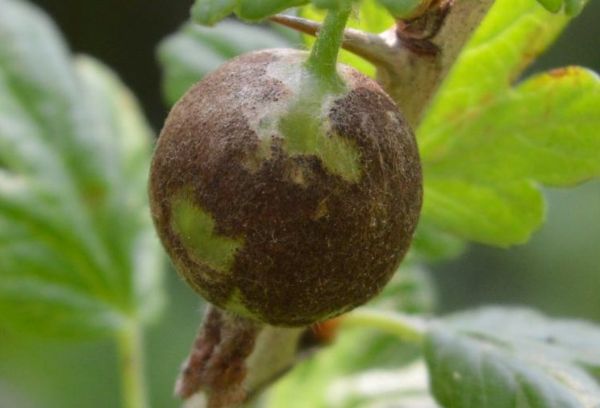

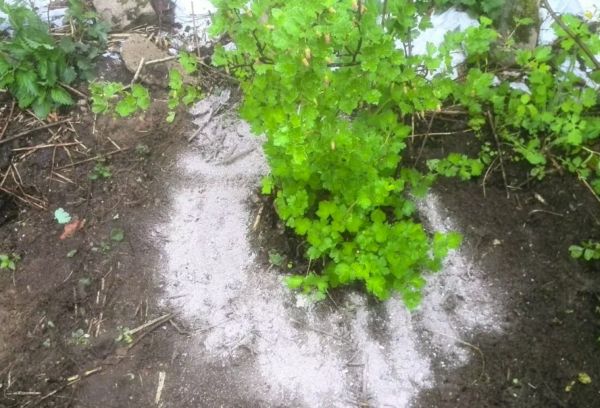

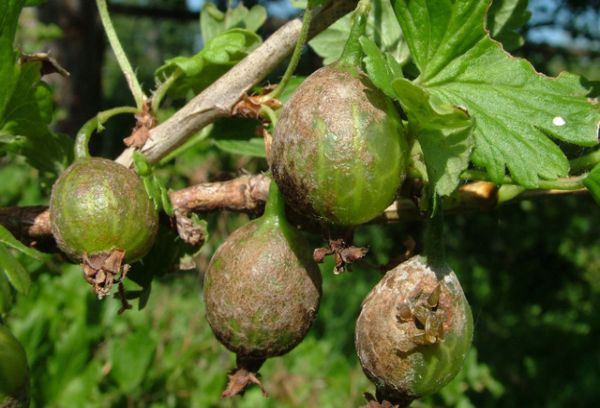

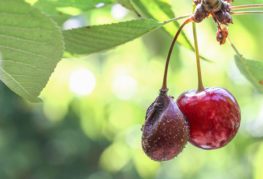
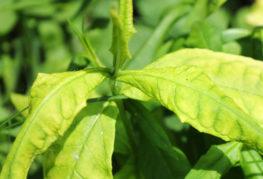
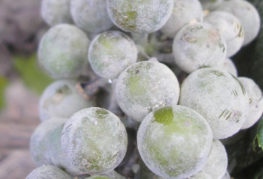
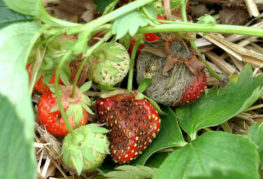
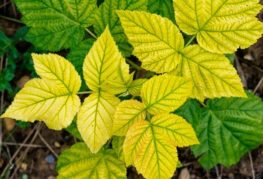
and will be published shortly.